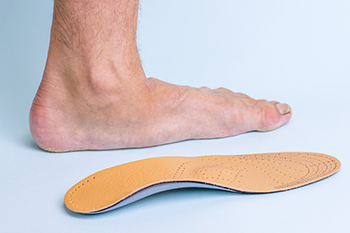
Sever’s disease is related to swelling and irritation of the growth plate in the heel of the foot during puberty (typically 9 to 14 years of age). The growth plate, an area of the foot that is weaker and more apt to sustain injury than the rest of the bone, is a layer of cartilage in the foot near the end of a bone where most of bone growth occurs. During a growth spurt, muscles and tendons can become tight and pull on the growth plate. Activities like sports or prolonged standing can aggravate this condition. A child who has Sever’s disease might complain about tenderness or pain in one or both of their heels, experience stiffness in their feet upon awakening, start limping or walking on their tiptoes, or feel pain when their heels are squeezed from both sides. If your child is experiencing heel or foot pain of any sort, a visit to a podiatrist is suggested for proper diagnosis of the problem and appropriate treatment. If properly treated (with rest, ice packs, over-the-counter pain relievers, shoe inserts, or more), Sever’s disease is usually not long-lasting or chronic.
Making sure that your children maintain good foot health is very important as they grow. If you have any questions, contact Bruce Smit, DPM of Frankfort Foot & Ankle Clinic. Our doctor can provide the care you need to keep you pain-free and on your feet.
Keeping Children's Feet Healthy
Having healthy feet during childhood can help prevent medical problems later in life, namely in the back and legs. As children grow, their feet require different types of care. Here are some things to consider...
Although babies do not walk yet, it is still very important to take care of their feet.
Avoid putting tight shoes or socks on his or her feet.
Allow the baby to stretch and kick his or her feet to feel comfortable.
As a toddler, kids are now on the move and begin to develop differently. At this age, toddlers are getting a feel for walking, so don’t be alarmed if your toddler is unsteady or ‘walks funny’.
As your child gets older, it is important to teach them how to take care of their feet.
Show them proper hygiene to prevent infections such as fungus.
Be watchful for any pain or injury.
Have all injuries checked by a doctor as soon as possible.
Comfortable, protective shoes should always be worn, especially at play.
If you have any questions please feel free to contact our office located in Frankfort, IL . We offer the newest diagnostic and treatment technologies for all your foot and ankle needs.

The feet, and the arch, bear the body’s weight, and provide support and shock absorption. The arch is composed of several different structures, with the ligaments providing the lion’s share of stability and support. Excessive forces placed on the feet due to obesity can change the foot’s structure, negatively affecting the ligaments of the arch, and even causing flat feet in many overweight people. Studies even suggest that the degree of an overweight person’s flat footedness is directly correlated to their level of obesity, with a higher Body Mass Index (BMI) correlated with a lower plantar arch height. People with flat feet might experience complications such as plantar fasciitis, muscle cramping, arthritis, Achilles Tendonitis, and other forms of foot discomfort or pain. A podiatrist can help anyone, regardless of weight, who is experiencing discomfort from flat feet with custom orthotic devices, supportive shoes, stretching exercises and stretches, physical therapy, pain management medication and more.
Flatfoot is a condition many people suffer from. If you have flat feet, contact Bruce Smit, DPM from Frankfort Foot & Ankle Clinic. Our doctor will treat your foot and ankle needs.
What Are Flat Feet?
Flatfoot is a condition in which the arch of the foot is depressed and the sole of the foot is almost completely in contact with the ground. About 20-30% of the population generally has flat feet because their arches never formed during growth.
Conditions & Problems:
Having flat feet makes it difficult to run or walk because of the stress placed on the ankles.
Alignment – The general alignment of your legs can be disrupted, because the ankles move inward which can cause major discomfort.
Knees – If you have complications with your knees, flat feet can be a contributor to arthritis in that area.
Symptoms
Treatment
If you are experiencing pain and stress on the foot you may weaken the posterior tibial tendon, which runs around the inside of the ankle.
If you have any questions please feel free to contact our office located in Frankfort, IL . We offer the newest diagnostic and treatment technologies for all your foot and ankle needs.
Ankle sprains are a fairly common injury to the rubber band-like ligaments that connect and hold the ankle bones together. Not all ankle sprains are the same. Severity depends upon how many ligaments are affected, and whether they are overly stretched, or partially/fully torn. Having weak ankles, running on uneven surfaces, playing sports, wearing inappropriate shoes, and having prior ankle sprains can increase a person’s risk of spraining their ankle. Along with pain, an ankle sprain may cause bruising, swelling, stiffness, soreness and even difficulty walking. If your ankle does not heal properly, it could lead to future ankle sprains and chronic ankle instability. Sometimes an ankle sprain will occur along with another type of foot or ankle injury that should be addressed as well. To avoid these problematic situations, contact a podiatrist if you believe you have sprained your ankle.
Ankle sprains are common but need immediate attention. If you need your feet checked, contact Bruce Smit, DPM from Frankfort Foot & Ankle Clinic. Our doctor can provide the care you need to keep you pain-free and on your feet.
How Does an Ankle Sprain Occur?
Ankle sprains take place when the ligaments in your ankle are torn or stretched beyond their limits. There are multiple ways that the ankle can become injured, including twisting or rolling over onto your ankle, putting undue stress on it, or causing trauma to the ankle itself.
What Are the Symptoms?
Preventing a Sprain
Treatment of a Sprain
Treatment of a sprain depends on the severity. Many times, people are told to rest and remain off their feet completely, while others are given an air cast. If the sprain is very severe, surgery may be required.
If you have suffered an ankle sprain previously, you may want to consider additional support such as a brace and regular exercises to strengthen the ankle.
If you have any questions please feel free to contact our office located in Frankfort, IL . We offer the newest diagnostic and treatment technologies for all your foot and ankle needs.
 A heel spur is actually referred to medically as a calcaneal spur. It is a small, bony protrusion that forms on the back of the heel, and it can cause pain and discomfort while walking. It can develop as a result of excessive strain on the foot muscles and ligaments, or it may come from a torn membrane that covers the heel bone. The pain from a heel spur is felt in back of the heel, which can cause the Achilles tendon to become inflamed. Heel spurs may be mistaken for the painful foot ailment known as plantar fasciitis, which can produce similar symptoms. Pain from a heel spur can make completing daily tasks difficult, and it is strongly advised that you are under the care of a podiatrist who can properly diagnose and treat heel spurs.
A heel spur is actually referred to medically as a calcaneal spur. It is a small, bony protrusion that forms on the back of the heel, and it can cause pain and discomfort while walking. It can develop as a result of excessive strain on the foot muscles and ligaments, or it may come from a torn membrane that covers the heel bone. The pain from a heel spur is felt in back of the heel, which can cause the Achilles tendon to become inflamed. Heel spurs may be mistaken for the painful foot ailment known as plantar fasciitis, which can produce similar symptoms. Pain from a heel spur can make completing daily tasks difficult, and it is strongly advised that you are under the care of a podiatrist who can properly diagnose and treat heel spurs.
Heel spurs can be incredibly painful and sometimes may make you unable to participate in physical activities. To get medical care for your heel spurs, contact Bruce Smit, DPM from Frankfort Foot & Ankle Clinic. Our doctor will do everything possible to treat your condition.
Heels Spurs
Heel spurs are formed by calcium deposits on the back of the foot where the heel is. This can also be caused by small fragments of bone breaking off one section of the foot, attaching onto the back of the foot. Heel spurs can also be bone growth on the back of the foot and may grow in the direction of the arch of the foot.
Older individuals usually suffer from heel spurs and pain sometimes intensifies with age. One of the main condition's spurs are related to is plantar fasciitis.
Pain
The pain associated with spurs is often because of weight placed on the feet. When someone is walking, their entire weight is concentrated on the feet. Bone spurs then have the tendency to affect other bones and tissues around the foot. As the pain continues, the feet will become tender and sensitive over time.
Treatments
There are many ways to treat heel spurs. If one is suffering from heel spurs in conjunction with pain, there are several methods for healing. Medication, surgery, and herbal care are some options.
If you have any questions feel free to contact our office located in Frankfort, IL . We offer the latest in diagnostic and treatment technology to meet your needs.